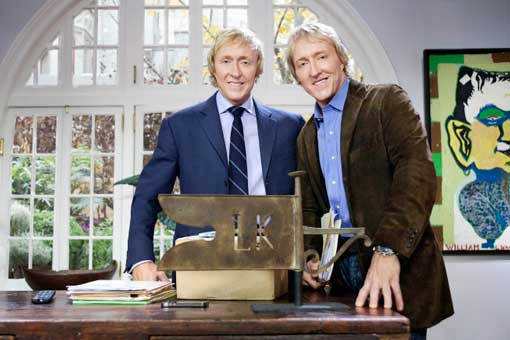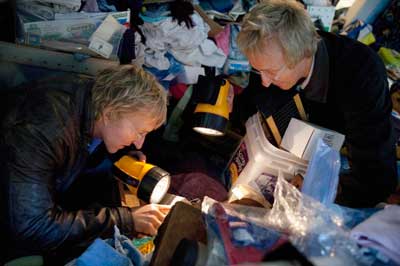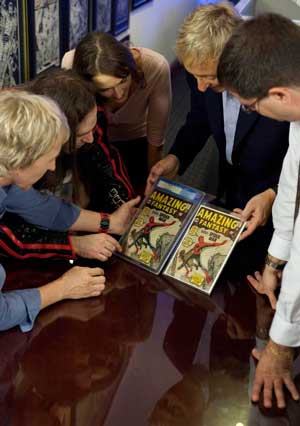
Wow! When I first heard about Fox's new Buried Treasure (Wednesdays at 8 p.m. ET), I thought: I'm going to love this show. It's Antiques Roadshow coming to houses like mine and justifying all those years of going to garage, church and yard sales. It's about everyday people picking up something for a dollar or a dime that is going to make them -- well, a millionaire.
Um, not quite.
Buried Treasure stars Leigh and Leslie Keno of PBS fame. The Keno brothers grew up surrounded by antiques -- their parents were both dealers -- and, according to them, have been fascinated by old objects since childhood. If you watch Roadshow, you will no doubt recognize them. They're those over-enthusiastic blond furniture appraisers who often get more excited about a "find" than its owner.
But rather than the mundane folks that people Roadshow, or even History Channel's Pawn Stars, the producers of Buried Treasure seem intent on upping the drama, and that means finding individuals who are sometimes as unusual and quirky as the objects they possess. The result? Something akin to a mashup of Roadshow and A&E's Hoarders.

The premiere opened with a mother and daughter from well-to-do Cold Spring Harbor, N.Y. Mom Liz Doering is living off the fumes of what daughter Lily describes, with some resentment, as "a lot of financial stability" that was squandered. Liz is also a hoarder who seems oblivious that the interior of her otherwise lovely home is a horror, piled high with her "stuff." She really loves her stuff and doesn't want to part with it. It is clear she could use professional counseling.
Her adult daughter wants the Kenos, whom she describes as "the rock stars of the antiques world," to find money in the mess that surrounds her mother. Lily, who has a 6-year-old daughter, complains that she buys the food and pays the bills and that "The answer to all our problems could be hiding under a sack of papers." Though shedding tears about how she wants to help Liz, Lily comes off as rather uncaring and coarse. Would a caring daughter expose her mother like this to her neighbors and community, not to mention the rest of the viewing world?
The Kenos "discover" five objects to take back to Manhattan to investigate further. Have they found Buried Treasure? We'll have to wait until the end of the show for the big reveal. It's a now commonplace TV reality technique that builds annoyance rather than suspense. (Note to the producers: People interested in a show about found objects don't need to be strung along to keep watching. Take a hint from Roadshow. Viewers get immediate gratification and are still watching after 14 years.)
Ultimately, all the items collected by the Kenos are valuable, including an ancient bronze Minoan bowl with a pre-auction value of $40,000 to $60,000. As the worth of each piece is announced, Lily jumps around and excitedly yells (bleeped) expletives, while Liz submissively agrees to let her treasures be sold. It is all rather sad to watch. I hated Lily and pitied Liz.

Next comes Manhattan comic book artist Graig Weich and his wife, Liga. Graig is also a collector of comics, and the couple's cramped, claustrophobic one-bedroom apartment is overrun by that collection. Graig thinks it might be time to sell some of his stuff and move forward with his life. But like a lot of collectors, he has trouble letting go. Two normally highly valued comics he brings to the Keno's comic book experts turn out to be damaged. Graig decides not to sell his restored Incredible Hulk No. 1 (mint: $20,000) for $2,200, but parts with a repaired comic featuring the first appearance of Spider-Man (mint: $200,000) for $5,400. He is conflicted over an offer of $58,000 for a 1941 Superman animation cel by Max Fleischer.
When his wife tells him to keep it because she knows he'll regret selling it, he is so touched by her gesture he decides he now wants to part with it. Ultimately he leaves the decision to Liga, who convinces him to keep it. True love conquers all, apparently, including practicality. The collector in me understands how hard it is to sell off pieces, but the objective observer in me found it hard to understand why they wouldn't trade the windfall for better living conditions.
Finally, we return to Long Island, where Greenport winemaker Leslie Howard believes he might have inherited a valuable 17th century violin, left to him when his dad perished in a sailing accident when Howard was 12. The Kenos' experts, however, determine it is an early 20th century reproduction worth $300.
Along with the fabricated drama (including appraiser valuations getting cut at "the pre-auction value is" point before a commercial, a technique from HGTV's If Walls Could Talk), we wish the producers of Buried Treasure would dump the current voiceover announcer who explains what items are and their worth. We'd much prefer the Kenos do that in standup segments or do their own voiceovers.
Though I won't give up on the show yet, previews of coming episodes promise more hoarders, which makes me wary. Then again, it appears that one woman will get news that she owns something worth a million dollars.
And let's not forget that promo at the end of the show soliciting viewers to apply to have the Kenos examine a special item they might possess. There must be something in my attic . . .